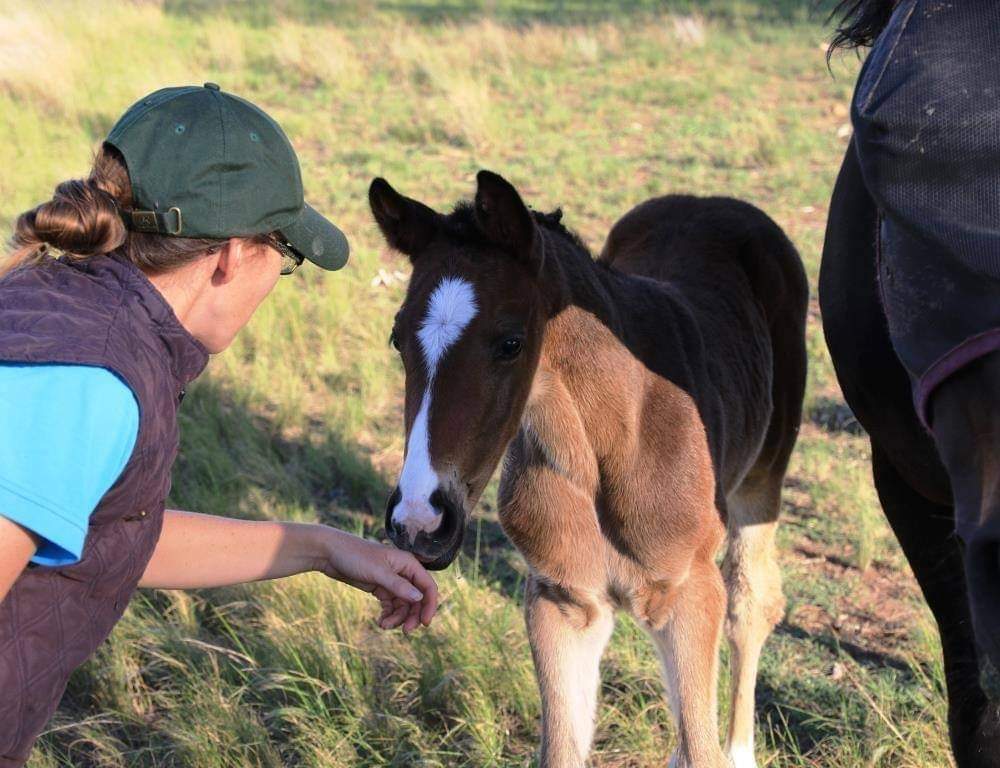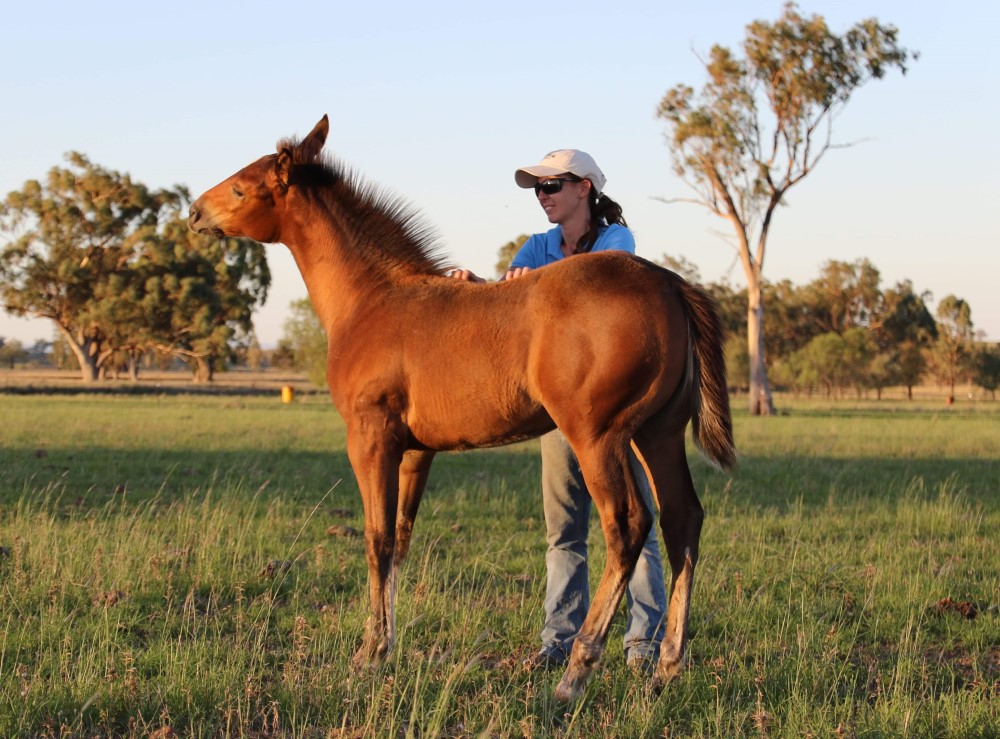Spring is here and some of us are lucky enough to be having foals… disturbed sleep, the excitement of the birth, delight in the new creature, and the stress – sometimes heartbreak – all go together.
The newborn foal is at the beginning of his relationship with humans. We want these early experiences to be positive. I really believe these early experiences can have a big impact on what that foal expects the relationship to be. We want him to enjoy time with humans, to even want to be with us, and to keep his curiosity and some playfulness in the relationship.
We want him to understand what is expected of him. For example, we want him to approach us, to accept and enjoy us touching him all over, to accept a halter and later to lead. Very soon we are teaching him to yield to pressure in a friendly way.

The time you take to help him learn to be confident with people, to help him want to be connected to people and to pay attention to people, is an investment in his future. Can you teach him to be a team player who wants to be on your team?
To take this approach to training foals, where the main goal is to build a trusting relationship with the foal, will in the short term take more time generally than if the main goal is to get the job done of haltering, leading and picking up legs. But the time invested will be repaid over the lifetime of the horse if these first lessons teach him to want to participate with humans.
Trust is the foundation of a good relationship. Trust leads to a sense of safety in a relationship. We want our horses to trust us and ideally to look to us as a secure base to explore the world and a safe haven to come to at times of stress. This view of relationship is informed by attachment theory, and is quite different from the view of relationship informed by the idea that horses are a herd animal and in the relationship we should be the leader of the herd. This idea leads to humans being dominant. This mindset can lead to aggressive behaviour on the human’s part.
To see yourself more as a parent leads to a gentler, trusting relationship. Parents should be bigger, stronger, wiser, and kind. Of course, we are only bigger and stronger than a foal when he is very young, but we can set clear boundaries that make us seem bigger and stronger, without violence, especially if we start when a foal is young.
BECOMING ATTUNED
So how do we do that? Start by trying to be attuned to your foal. Approach him and try to notice when he starts to pay attention to you. Notice when he feels uncomfortable with your proximity and just back off to where he is comfortable. Let him feel safe, not feel threatened by your presence. If he goes to move away, maybe just sit down and wait until his curiosity gets the better of him and he approaches you. You can see what happens if you walk away a bit while he is approaching. Will he follow you? Any time he is uncomfortable with you just move back a little until he looks relaxed. A relaxed foal will lower his head, he may graze, he may chew, he will look soft in the eye.
Your goal is to be sensitively attuned to him, to notice the signs he is uncertain about you – head up, tension in his muscles, around the muzzle, a sense of alertness – and to back off immediately. If he is comfortable, you can approach a bit more. Try to touch him first on his chest or wither, where he is likely to enjoy a scratch. Touching his head will come after he has accepted your touch in less sensitive areas.

A very shy foal may feel safer if you spend time grooming his mother, or perhaps feeding her out of a bucket. You can stand near her shoulder on the side opposite to the foal and reach around her chest and see if his curiosity is aroused, and he will touch and sniff your hand when it is touching his mother. A foal’s curiosity is a great asset to training.
When he accepts touch, he may accept putting his head into the halter. Offer the halter and see what he makes of it rather than wrestling him to get it on. This may take patience on your part, but if it is possible to let him learn that it’s his idea to do what we want, that is a good thing. If he is naturally a bit head shy sometimes a rope around his neck can help him to learn not to run away.
We care for our foals in large boxes for the first few days to make it easier for them to learn about us. Short lessons repeated often are best. Five minutes at feeding up times and any other time that fits in. We try to give them several opportunities a day to get to know us and to learn that we are attuned to them and that we give good scratches.
When he enjoys your touch, you can start to touch the more sensitive parts. Start to run your hands down his legs, but only as far as he is comfortable. Slide your hand back to the area he likes to be scratched when you notice he is uncomfortable. He will learn to accept you very quickly when he knows that you’re attuned and noticing his discomfort and responding to it. Soon he will allow you to lift a leg. If your foal is a sensitive foal who tends to kick, it is best to have the halter on him so that you can keep his head turning towards you – and sometimes using a brush with a handle or a duster will help you keep a safe distance from potentially kicking hooves is best.

POSITIVE REINFORCEMENT
As always, use positive reinforcement when possible. Scratches in his favourite place when he does the right thing. When your foal is old enough to be eating solid foods, you can start to use food rewards. Reward the right behaviour, don’t use food as a bribe. If he gets pushy or goes to nip, reprimand him with your voice and push him away on his chest or by squeezing the big muscle on the underside of his neck.
As he gets more confident you can teach him a few foundations. I like to introduce the clicker to foals. You can easily target train a foal just as any other horse once they are interested in rewards. For more detail how to do this, see my previous article on positive reinforcement in the June 2022 issue of Equestrian Life.
You can teach him to pick up his legs, to accept a rug. He needs to learn to lead, which is the first big lesson in yielding to pressure. We prefer to start this by tying him with a neck strap on to his mother. She is equipped with a roller and connected car tyre inner tube as a neck collar. This way he will naturally pull away from the pressure, but when he naturally goes to be nearer to her the pressure is released. Foals learn to lead incredibly fast when their mothers teach them, and I believe this is the least stressful for them. Furthermore, the human is not the source of the stress.

Once he can lead you can start to teach him to maintain a suitable distance away from you. You can even start to teach the basic groundwork pattern. Bending the neck, head down, forward, backwards, yield the hindquarters, yield the shoulder. The trick to working with foals is short lessons, no pressure, reward an attempt, avoid punishments. Try to make it fun, make the right thing easy and the wrong thing difficult by setting your foal up for success by asking for small things. Animals (and humans) get a little burst of dopamine, the pleasure neurotransmitter, whenever they perform a task they have been taught. So, this early training if done correctly sets the foal up to be a willing learner, a willing partner, a creature who wants to participate with people. EQ
YOU MIGHT ALSO LIKE TO READ BY KERRY MACK:
Perfecting the Short Side – Equestrian Life, October 2023
The Subtle Art of Suppleness – Equestrian Life, September 2023
Perfecting The Pirouettes – Equestrian Life, August 2023
Get In The Zone & Go With The Flow – Equestrian Life, July 2023
How to Resolve Common Problems – Equestrian Life, June 2023
A Smarter Way to Compete – Equestrian Life, May 2023
What Motivates Me – Equestrian Life, March 2023
More Than a Walk in the Park – Equestrian Life, February 2023
Scott Keach Makes His Own Luck – Equestrian Life, December 2022
No Room for Bullying in Our Sport – Equestrian Life, November 2022
Avoid the Mud (Play Indoors) – Equestrian Life, October 2022
Why We Love Our Sport – Equestrian Life, September 2022
Getting on the Bit – Equestrian Life, July 2022
Positive Training Really Clicks with Horses – Equestrian Life, June 2022
Learn From Your Mistakes – Equestrian Life, March 2022 issue
Young Horse Classes: A Fun Launching Pad – Equestrian Life, February 2022
Making Sense of all the Bits & Pieces – Equestrian Life, January 2022
The Secret to ‘Soft Hands‘ – Equestrian Life, December 2021
Ask Less, Reward More – Equestrian Life, October 2021
So You Want To Go To The Games? – Equestrian Life, September 2021
The Ins & Outs Of Bitless Bridles – Equestrian Life, July 2021
Taking The Plunge With The Lunge – Equestrian Life, June 2021
Dressage for Showjumpers – Equestrian Life, May 2021
23 Shoulder-In Exercises to Improve Your Horse – Equestrian Life, April 2021
Understanding Your Horse’s Inner Thoughts – Equestrian Life, March 2021
Make the Most of Your Seniority – Equestrian Life, February 2021
Building Better Relationships – Equestrian Life, January 2021
Whipping Up Controversy – Equestrian Life, December 2020
The Importance of a Trusting Relationship – Equestrian Life, November 2020
Welcome to Kindergarten for Foals – Equestrian Life, October 2020
The Carrot or the Liquorice? Positive Reinforcement – Equestrian Life, September 2020
Submission or Stress? Something to Chew On – Equestrian Life, August 2020
A Relaxed Horse is a Happy Horse – Equestrian Life, July 2020
The Literate Horse Rider – Equestrian Life, June 2020
Why Horses Love Ingrid Klimke – Equestrian Life, May 2020

